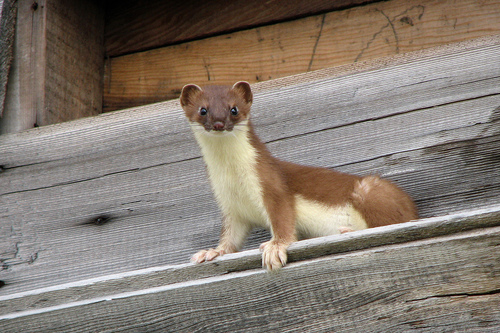
Stoat
The stoat, Mustela erminea, is a master of disguise, boasting a seasonal coat that shifts from brown to snowy white. This nimble predator thrives in varied habitats, hunting with agility and precision. Its dynamic role in pest control highlights its ecological importance.
7-10 years
Lifespan
60.0 - 110.0 g
Weight
Length: 23 - 31 cm
Size
Brown, Black, White
Color
few months months
Age of Sexual Maturity
8 mph
Top Speed
Least Concern
Conservation Status
Stable
Population Trend
Characteristics
The stoat, Mustela erminea, is a small carnivorous mammal with a slender body, long neck, and short legs. Its fur changes from brown in summer to white in winter, a process called molting, aiding camouflage in snowy environments. Stoats are agile hunters, preying on rodents, birds, and insects. They inhabit diverse environments, from woodlands to grasslands, across the Northern Hemisphere.
Distribution Range of the Stoat
Mustela erminea, commonly known as the stoat or ermine, is native to the Holarctic region, which includes parts of North America, Europe, and Asia. In North America, it is found throughout Canada, Alaska, and parts of the northern United States. In Europe, it ranges from the British Isles and Scandinavia to the Ural Mountains in Russia. In Asia, its range extends across Siberia and into parts of northern China and Japan.
Stoat's Habitat
Environmental Conditions
The stoat is highly adaptable and inhabits a variety of environments, including forests, grasslands, tundra, and wetlands. It prefers areas with dense ground cover, such as thick underbrush or tall grass, which provide protection and hunting opportunities. The climate in its range varies widely, from the cold arctic regions to temperate zones, but the stoat is particularly well-adapted to colder environments.
Ecological Niche
Mustela erminea is a carnivorous mammal, playing a key role as a predator in its ecosystem. It primarily preys on small mammals like rodents and rabbits, but it also eats birds and insects when available. The stoat's ability to adapt to different environmental conditions allows it to occupy a broad ecological niche, and it is known for its agility and hunting prowess. In colder regions, the stoat's fur changes to white during the winter months, a camouflage adaptation known as 'ermine,' which helps it blend into snowy landscapes.
Copyright @ Nature Style Limited. All Rights Reserved.
 English
English